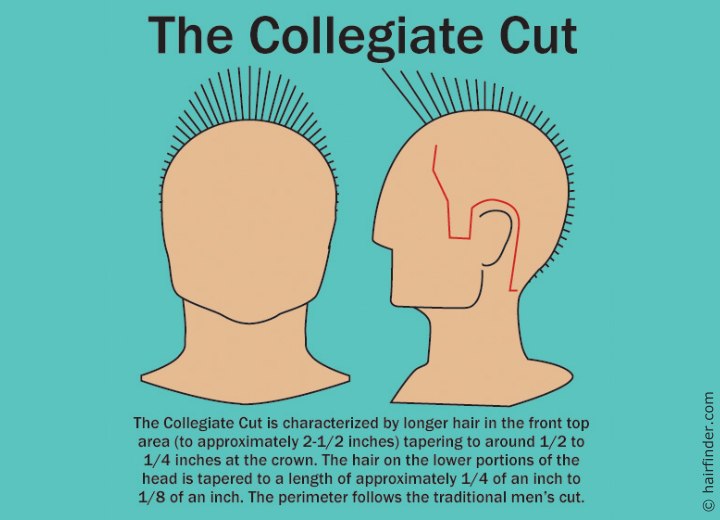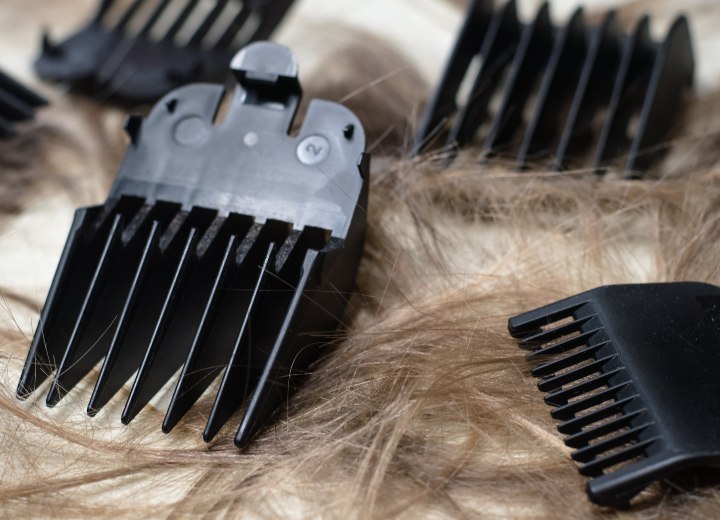Clipper Cutting Techniques (2)

The following are cuts that are recently popular once more and feature longer hair at the bangs area:
Caesar Cut: The Caesar Cut is generally clipper cut hair to a uniform length of about one inch all over the head, and left slight longer at the forehead edge to be combed downward in straight-edged bangs. The perimeter of the hair follows a traditional men's cut - around the ears and squared at the neck.
There is a variation found in the length of most Caesar Cuts depending on the preferences of the wearer and the density of the hair. Those individuals with denser hair (thicker) may prefer a shorter cut, but the hair is rarely shorter than ½ inch all over the head.

Collegiate Cut: Also known as an Ivy League Cut, the Collegiate Cut is a tapered haircut that is shortest at the bottom perimeter of the hair (sides and back) and gradually increases in length from the crown to the front forehead area.
The bottom of the hair may start as short as 1/8 inch at the neck and bottom sides, increase to 1/2 inch at the parietal ridge and crown area, and slowly increase to as much as 2 inches or a little longer at the front of the head.
Other Terms:
The following are terms often heard in reference to clipper cut styles along with what they mean:
Fade (or Temple Fade): A fade is tapering of the hair to the shortest possible length of stubble. Usually used with Buzz Cuts, Crew Cuts and Flattop styles, the fade generally starts just below the parietal ridge around the temple area.
White Walls: Another taper cut that goes even shorter than a fade. The hair is tapered to the shortest possible stubble length at a point just below the parietal ridge and the hair below that point is shaved completely with a lather and razor to smooth skin.
Taper: A term that generally refers to gradually decreasing lengths of hair - typically becoming shorter as you go down the head to the lower perimeter of the hairline on the sides and back. When referring to the finishing technique of a haircut, tapering means that the hair is cut gradually shorter and shorter but the natural hairline is left intact.
Squared: This term refers to the technique of cutting an artificial line in the perimeter, particularly at the back of the head near the neck. The hair may be tapered above the perimeter, but generally is longer than with a tapered finish to ensure a clean line in the squared off hairline.

The following are the terms for lengths most commonly used by barbers, which refer to the lengths of various clipper settings and guard attachments:
• #0 (no attachment) - 1/100 inch,
• #1 - 1/8 inch,
• #2 - 1/4 inch,
• #3 - 3/8 inch,
• #4 - 1/2 inch,
• #5 and #6 - special tapering attachments
• #7 - 7/8 inch, and
• #8 - 1 inch.
The relevance of these numerical identification terms is easy to understand. By using standardized terms for the lengths of the guard attachments, a person can walk into almost any barbershop and ask for a “#2 Buzz Cut” and know that they will get their hair clipped to a uniform length of 1/4 inch all over the head.
Manufacturers of various clippers use almost universal standardization for the lengths of the guard attachments. There is some variation in length to be found from manufacturer to manufacturer, but the differences in length tend to be around 1/32nd of an inch or less. The variation rarely presents a problem for either barber or customer.
©Hairfinder.com
See also:
How to cut hair with clippers
How to fade with clippers
